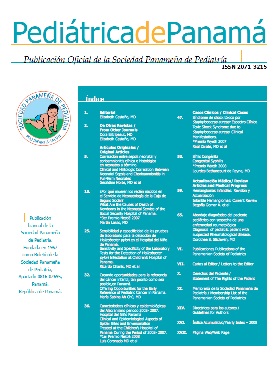Efficiency of High Flow Nasal Cannula in Pediatric Respiratory Pathologies
Authors
DOI:
https://doi.org/10.37980/im.journal.rspp.20211741Keywords:
High Flow Nasal Cannula, Non-invasive ventilation, Invasive mechanical ventilation, Acute respiratory failure, Pediatric intensive care unitAbstract
Introduction: During pediatric ages there are important predisposing factors that make children more vulnerable to present acute respiratory failure (ARF).
Objective: Determine the benefits of the use of high flow nasal cannula (HFNC) in patients younger than 5 years with ARF, secondary to respiratory diseases and admitted to the pediatric intensive care unit (PICU).
Subjects and Method: Analytical observational study of mixed type cohorts, where a cohort is formed by the group exposed to HFNC and evaluated prospectively, while it was compared with a historical cohort.
Results: 138 patients were admitted to the study of which 69 were cases handled with HFNC and 69 were controls who were not exposed to the use of HFNC but to other types of invasive mechanical ventilation. Oxygen therapy days were statistically shorter in the case group from 13 (SD 8.01) days to 22 (SD 20.7) days in the control group (P = <0.05). The length of stay in PICU and the total inpatient days were lower in the group managed with HFNC (P = 0.011, P = 0.001), with a mean time of 10 (SD 7.8) days in PICU and 17 (SD 9.25) inpatient days for the case group versus 14 (SD 10.1) days in PICU and 28 (SD 23.9) inpatient days for the control group.
Conclusion: HFNC system is a non-invasive respiratory support method, simple, effective and easy to use in the pediatric population less than 5 years of age with ARF due to various respiratory diseases.
Downloads
Published
Issue
Section
License
Copyright (c) 2021 Infomedic InternationalDerechos autoriales y de reproducibilidad. La Revista Pediátrica de Panamá es un ente académico, sin fines de lucro, que forma parte de la Sociedad Panameña de Pediatría. Sus publicaciones son de tipo gratuito, para uso individual y académico. El autor, al publicar en la Revista otorga sus derechos permanente para que su contenido sea editado por la Sociedad y distribuido Infomedic International bajo la Licencia de uso de distribución. Las polítcas de distribución dependerán del tipo de envío seleccionado por el autor.






